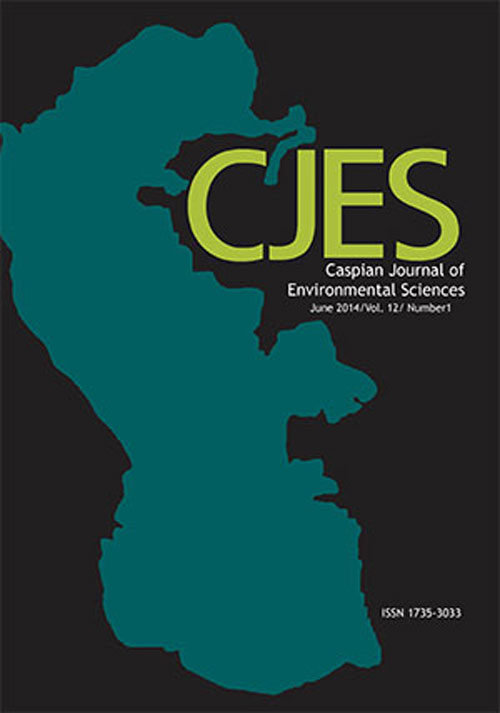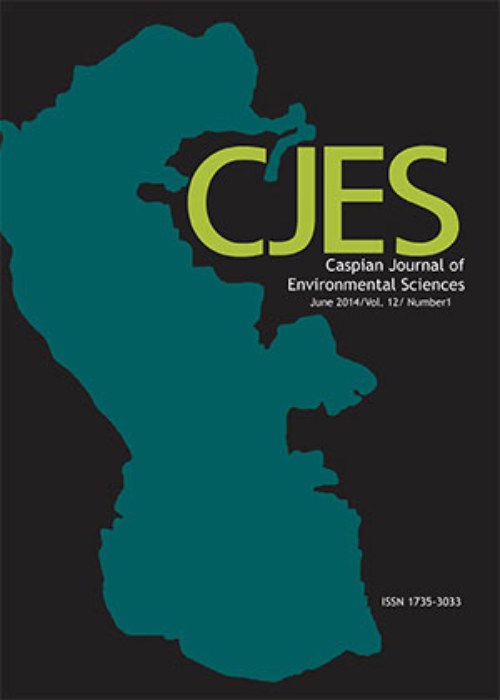فهرست مطالب

Caspian Journal of Environmental Sciences
Volume:13 Issue: 4, Autumn 2015
- تاریخ انتشار: 1394/10/30
- تعداد عناوین: 9
-
-
Pages 293-331The genus Alburnoides Jeitteles, 1861 in Iran is reviewed, and diagnoses are presented for all eight recognized species. Alburnoides eichwaldii, A. holciki, A. idignensis, A. namaki, A. nicolausi, A. petrubanarescui, A. qanati and A. tabarestanensis are considered valid and three new species are described: Alburnoides coadi sp. n., from Namrud River in Kavir basin, A. parhami sp. n., from Atrak River in the south-eastern Caspian Sea basin, and A. samiii sp. n., from Sefidroud River in the southern Caspian Sea basin. All species, except unstudied A. petrubanarescui are illustrated and characterized morphologically.Keywords: New species, Taxonomy, Freshwater fishes, Alburnini, Spirlin
-
Pages 333-347The performance of geostatistical and spatial interpolation techniques were investigated for estimation of spatial variability of heavy metals and water quality mapping of groundwater resources in Ramiyan district (Golestan province, Iran). 24 spring/well water samples were collected and the concentration of heavy metals (Ni, Co, Pb, Cd and Cu) was determined using differential pulse polarography. Multivariate and geostatistical methods have been applied to differentiate the influences of natural processes and human activities as the sources of heavy metal pollutants in groundwater across the study area. The results of the cluster analysis and factor analysis show that Ni and Co are grouped in the factor F1, whereas, Pb and Cd in F2 and Zn and Cu in F3. The probability of presence of elevated levels for the three factors was predicted by utilizing the most appropriate Variogram Model, whilst the performance of methods, was evaluated using mean absolute error, mean bias error and root mean square error. The spatial structure results show that the variograms and cross-validation of the six variables can be modeled with three methods, namely, the radial basis fraction, inverse distance weight and ordinary kriging. Moreover, the results illustrated that radial basis fraction method was the best due to its highest precision and lowest error. The geographic information system can fully display spatial patterns of heavy metal concentrations in groundwater resources of the study area.Keywords: Groundwater, Heavy metals, Geostatistical, Multivariate statistics, Interpolation, Spatial mapping
-
Pages 349-361Heavy metal contamination was evaluated around the National Iranian Lead and Zinc Company (NILZ) in Zanjan province. Collected data were used to appraise the degree of soil contamination and also the source of pollution in the study area based on geoaccumulation index (Igeo), and enrichment factor (EF). The levels of Fe, Zn, Cd and Pb in the samples exceed those reported in literature. The analyzed soils can be considered unpolluted to moderately polluted by Cd and Pb, and moderately polluted by Zn. Evaluated EF also showed moderate to severe enrichment of the soil samples by Zn and Pb, and very strong enrichment by Cd. These results indicated an anthropogenic contribution mainly for Zn, Cd and Pb elements. Bivariate correlation among the investigated metals showed the contamination of soil around the study area resulted from the NILZ Company activity. Based on the MannWhitney assessment, it was found that the presence of Co, Cu, Zn, Cd and Pb was also attributed to the plant. Parametric and non-parametric tests revealed the leaching of metals to deeper soil layers. Hierarchical Clustering Analysis (HCA) allowed categorizing the investigated metals in three groups. These groups were cluster I (Zn, Cd, Co and Ni), cluster II (Pb and Cu) and Fe in an independent cluster III. Principal Component Analysis (PCA) and Factor Analysis (FA) elucidated the anthropogenic source of the pollutants.Keywords: Heavy metals, Geoaccumulation index, Enrichment factor, Statistical analysis
-
Pages 363-371The relationship between some habitat factors and fish assemblage was analyzed in the Taleghan River, Alborz Province, Iran. Fish specimens from thirty-three sites were sampled by electrofishing device in October 2014. The habitat parameters, including elevation (m), water depth (cm), river width (m), river slope (%), current velocity (m.s-1), number of large stone (> 15 cm), average stone diameter (cm), substrate index (SI%), level of potamal cover, level of periphyton cover, pH, electrical conductivity, total dissolved solid and temperature (°C) were measured in all sampling sites. Canonical correspondence analysis was performed to study the relationship between fish assemblage and environmental factors. The results showed that the fish assemblages of the Taleghan River are organized by the environmental variables. Based on the results, the abundance of C. gracilis did not show any distinctive relationship with examined habitat variables, whereas the presence and abundance of B. cyri showed a rise with increasing substrate index and bed stone diameter and a decline with increasing river width and flow velocity. The presence and abundance of O. bergianus rises with the increasing current velocity and river width and showed a decline with increasing slope, depth and substrate index. The results of this study provides insights into the ecology of fishes in the Taleghan River and can help an effective fisheries management of other rivers of the Caspian Sea basin.Keywords: Fish, Environmental variables, Diversity, Canonical correspondence analysis
-
Pages 373-382The aim of this research was to measure the relative efficiency of forest management plans in north of Iran. In order to fulfill the research, data of 12 forest management plans were collected from the financial balance sheets of Shafaroud Forest Company during a ten years period. First of all, basic Data Envelopment Analysis (DEA) models (BCC and CCR) were used to determine the efficiency. Then, due to the structure of the forest management plan, cost efficiency and revenue efficiency models based on DEA were used in order to measure the efficiency. Results indicated that 8 forest management plans were efficient based on BCC and CCR models. Furthermore, the results indicated that only one forest management plan was efficient based on cost efficiency and revenue efficiency models. These results could be due to the input oriented properties of the models, rational management and optimal use of resources.Keywords: Data envelopment analysis, cost efficiency models, revenue efficiency models, Iranian Caspian Forests
-
Pages 383-390One of the possible threats in increasing use of nanomaterials is the emergence of toxicity in humans and other animals which is discussed in nanotoxicology. In addition to toxic effects of nanomaterials themselves, different chemical precursors which are usually used in bottom-up approaches for production of nanomaterials may have secondary toxic effects in living organisms. In contrast, less use of chemicals in top-down approaches may reduce these secondary effects. To test this hypothesis, toxic effects of two types of silver nanoparticles (AgNPs) produced by physical (top-down) and chemical (bottom-up) methods were investigated and compared on the tadpole, Rana ridibunda survival. The estimated 48 h LC50 values of AgNPs produced by chemical and physical methods for tadpoles were 0.055 ± 0.004 and 0.296 ± 0.085 mg.L-1, respectively. No observed effect concentration, lowest observed effect concentration, maximum acceptable toxicant concentration and median lethal concentration of AgNPs produced by chemical method were respectively 3.42, 4.50, 4.84 and 5.38 times less than those produced by physical method. Therefore, approving the mentioned hypothesis, it was revealed that AgNPs produced by chemical method are more toxic than those generated by physical method. However, it seems totally that AgNPs regardless of the method used for their production, have toxic effects on aquatic organisms and so, inhibiting their accidental or intentional entrance into the aquatic ecosystems should be more considered.Keywords: Amphibian, Aquatic Nanotoxicology, Rana ridibunda, Silver Nanoparticles, Tadpole
-
Pages 391-405Mud volcanoes are defined as main elements of geological structures and ways through and within which buried argillaceous loose sediments and lithified rocks. The Gharniaregh Tappeh and Naftelijeh mud volcanoes are the most attractive geomorphological phenomena in continental which appear along the eastern coast of the Caspian Sea. The Naftelijeh mud volcano is more active than GharniareghTappeh, while the latter is saltier than the former, indicating its proximity to salt domes. The ejected materials from these mud volcanoes are often comprised slurry of fine solids silt and clay suspended in liquids, which may include water (frequently acidic or salty) and hydrocarbon fluids. The most part of the gases released are methane. Carbon dioxide and nitrogen are also emitted but in much lesser quantities. The complicated morphology of the volcanoes can be rough terrain, cone-shaped and buildings mentioned columnar shape. The morphology of the effects can be uneven terrain such as hills and buildings used in the column. Emissions caused significant environmental impact, including the loss of plants and vegetation destruction is quite evident in the region. Like all other natural phenomena, mud volcanism phenomenon can affect the environment both positively and negatively, which is discussed here. Catastrophic reduction of Paleo - Caspian size combined with the increasing scale of mud volcanic activity caused the oversaturation and intoxication of water by methane leading to the mass extinction of mollusks, fishes and other groups of sea inhabitants.Keywords: Caspian, Geomorphology, Gharniaregh Tappeh, Mud Volcanoes, Naftelijeh
-
Pages 407-417Oligochaeta worms are important organisms in aquatic ecosystem. Their omnipresence makes them as an indicator of environmental changes and health of aquatic ecosystem. The members of the family Tubificidae and in particular, genus Limnodrilus are considered as the most tolerant oligochaets to aquatic pollution. Therefore identification and biological characteristics of this taxon are of great help to evaluate the ecosystem of water bodies. Limnodrilus claparedeianus were collected from Anzali Wetland with a grab of 0.04 m2 capacity at 13 stations from August 2012 through June 2013. Penis sheath was one of the main characteristics to identify them. Results showed their maximum and the minimum density in spring (601.27 ± 466.8346 Ind.m-2) and in autumn (156.12 ± 136.3 Ind.m-2) respectively which was significantly different (PKeywords: Anzali Wetland, Limnodrilus claparedeianus, new record
-
Pages 419-427The purpose of the study was to verify, through the use of an experimental method, the assumption that the economic human pays more attention to the externality he/she causes as the strength of externality increases. We used a social-experiment design within an undergraduate classroom to test assumptions, using statistical method. A lakeside plant was used as an example. Our results confirmed the following: (1) 66% of subjects behaved altruistically, while the remainder (34%) behaved selfishly, suggesting that the assumption of mainstream economics may not be appropriate; (2) when we compared situations in which the plots with the natural resource (e.g. the plant) to which the economic human had property rights were large or small in number, those who possessed larger plots tended to be more conservative in resource use; and (3) when we compared situations where the economic humans extent of influence on natural resources was large or small, those with greater influence tended to be more conservative in resource use. Although mainstream economics assumes a rational economic humanwho is supposedly selfishour results suggest that altruistic behaviour dominates selfish behaviour, and that altruistic behavior should be taken into greater consideration when making policy.Keywords: altruism, environmental issues, experimental economics, externality, homo economicus, lake


